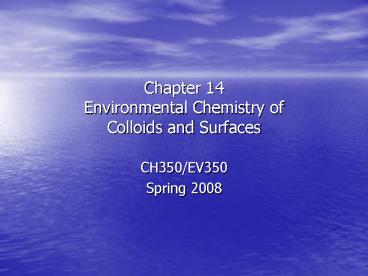Chapter 14 Environmental Chemistry of Colloids and Surfaces - PowerPoint PPT Presentation
1 / 23
Title:
Chapter 14 Environmental Chemistry of Colloids and Surfaces
Description:
... in water to be 1 ng/L while the concentration in mussels was 300 mg/kg ... BCF for mussels = (300 x 10-6 g DDT/kg)/(1 x 10-9 ng DDT/kg) = 300,000 ... – PowerPoint PPT presentation
Number of Views:1215
Avg rating:3.0/5.0
Title: Chapter 14 Environmental Chemistry of Colloids and Surfaces
1
Chapter 14Environmental Chemistry of Colloids
and Surfaces
- CH350/EV350
- Spring 2008
2
Colloids
- Interface between water and sediment
- Interface between soil and pore water
3
Colloids
- Colloids are in the size fraction between soluble
and precipitated. - Colloids have a defined size of 10 nm to 10 mm
- Experimentally, materials that pass through a
0.45 mm filter are considered dissolved
4
Colloids and surface area
- Small particles have large surface areas
- Humic and Fulvic acids have large surface areas
5
Colloid surface properties
- Adsorption of molecules or ions to surface
- Reversible adsorption temporarily removes
molecule from surrounding solution - Irreversible adsorption permanently removes
molecules from surrounding solution - Electrostatic attraction is one type of
adsorption mechanism - Depends on surface charge
- Clay minerals have relatively constant surface
charge - Iron and aluminum oxides have variable surface
charge depending on solution pH
6
Colloid surface charge
- Humic material
- Negative charge if carboxylic acid groups are
deprotonated - Positive charge (unlikely at normal pH) if amine
groups are protonated - Protonation/Deprotonation equilibrium is a unique
property of each material - pH where there is nosurface charge is knownas
the point of zerocharge (pH0) - If pH lt pH0 than surfaceis positively charged
- If pH gt pH0 than surfaceis negatively charged
7
Colloid surface charge
- Natural waters have pH near 7 so most colloids
exist with negative surface charge - Iron and aluminum oxides may have positive
surface charge under some conditions
8
Colloid electric double layer
- Surface of colloid attracts ions of opposite
charge so that the distribution of ions at the
surface is different than that of bulk water
9
Colloid electric double layer
- High salt concentrations decrease thickness of
double layer - Colloids become destabilized and aggregate
together to form larger particles which then
settle out - This occurs where rivers discharge colloids into
sea water causing sedimentation near the mouth of
the river
10
Ion exchange
- Colloid-Na K ? colloid-K Na
- Ca2 gt Mg2 gt K gt Na
- Ca2 binds more strongly than Na
- Ca2 will displace Na
- At low pH Al3 and H may also be important
cations in colloid surface chemistry - The measure of the amount of ions a colloid can
bind is known as the cation exchange capacity
(CEC) - Units of centimoles of positive charge per
kilogram of solid (cmol ()/kg)
11
Specific adsorption
- Covalent bonds are formed during specific
adsorption - Not related to surface charge but to specific
combinations of interactions between surface and
molecule
12
Langmuir relation
- Assumptions of Langmuir binding
- specific number of binding sites
- All sites are the same
- Once filled no more binding can occur
13
Langmuir relation
- Cs quantity adsorbed (mol/g)
- Caq quantity in aqueous phase (mol/L)
- Csm maximum quantity adsorbable (mol/g)
- b binding constant (L/mol) depends on the
physical and chemical nature of the solid material
14
Langmuir relation rearranged to linear form
- Cs quantity adsorbed (mol/g)
- Caq quantity in aqueous phase (mol/L)
- Csm maximum quantity adsorbable (mol/g)
- b binding constant (L/mol) depends on the
physical and chemical nature of the solid material
15
Freundlich relation
- Deviations from Langmuir binding
- Not all sites are the same, adsorption becomes
more difficult as adsorbate accumulates on the
surface - Once surface is filled additional species can be
adsorbed multilayered adsorption - Completely empirical no defined binding
mechanism
16
Freundlich adsorption
- Cs quantity adsorbed (mol/g)
- Caq quantity in aqueous phase
- KF (L/g) and nF (dimensionless number usuallylt
1) are empirical Freundlich constants
17
Partitioning between water and soil/sediment
- Kd depends on
- Organic solute
- Chemical nature of solid phase
- Temperature
- Ionic strength
- Sorption can occur on
- Mineral surfaces (MM) usually small
- Organic components (OM)
18
Octanol/water partition coefficient
- Octanol has hydrophobic and hydrophilic
characteristics - Used to approximate humic material binding
19
Octanol/water partition coefficient
- Larger Kow values when compound is hydrophobic
- Compounds will bind with humic materials rather
than be in the freely dissolved state
20
Uptake of chemicals by organisms
- Bioconcentration higher concentration of a
chemical in an organism than in the surrounding
environment - 1989 measurements in Scotland showed DDT
concentrations in water to be 1 ng/L while the
concentration in mussels was 300 mg/kg - Bioconcentration factor (BCF) ratio of chemical
in organism to that in the environment - BCF for mussels (300 x 10-6 g DDT/kg)/(1 x 10-9
ng DDT/kg) 300,000
21
Uptake of chemicals by organisms
- Bioaccumulation process by which an organism
takes up and retains a chemical - Biomagnification process that results in a
chemical being increasingly concentrated at
higher levels of the food chain
22
Uptake of chemicals by organisms
- Compounds with larger Kow values will likely
associate with lipid regions of organisms - BCF is usually correlated with Kow
23
Behavior of compounds in the aquatic environment
- Compounds can exist in freely dissolved state or
complexed with minerals, organic matter
particles, dissolved organic matter, black
carbon, or organisms - All these areas need to be considered to
accurately account for the physical state of a
compound in water































